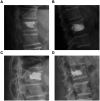Establishing a nomogram to predict refracture after percutaneous kyphoplasty by logistic regression
- PMID: 38187823
- PMCID: PMC10767997
- DOI: 10.3389/fninf.2023.1304248
Establishing a nomogram to predict refracture after percutaneous kyphoplasty by logistic regression
Abstract
Introduction: Several studies have examined the risk factors for post-percutaneous kyphoplasty (PKP) refractures and developed many clinical prognostic models. However, no prior research exists using the Random Forest (RF) model, a favored tool for model development, to predict the occurrence of new vertebral compression fractures (NVCFs). Therefore, this study aimed to investigate the risk factors for the occurrence of post-PKP fractures, compare the predictive performance of logistic regression and RF models in forecasting post-PKP fractures, and visualize the logistic regression model.
Methods: We collected clinical data from 349 patients who underwent PKP treatment at our institution from January 2018 to December 2021. Lasso regression was employed to select risk factors associated with the occurrence of NVCFs. Subsequently, logistic regression and RF models were established, and their predictive capabilities were compared. Finally, a nomogram was created.
Results: The variables selected using Lasso regression, including bone density, cement distribution, vertebral fracture location, preoperative vertebral height, and vertebral height restoration rate, were included in both the logistic regression and RF models. The area under the curves of the logistic regression and RF models were 0.868 and 0.786, respectively, in the training set and 0.786 and 0.599, respectively, in the validation set. Furthermore, the calibration curve of the logistic regression model also outperformed that of the RF model.
Conclusion: The logistic regression model provided better predictive capabilities for identifying patients at risk for post-PKP vertebral fractures than the RF model.
Keywords: anterior vertebral height; logistic regression; percutaneous kyphoplasty; random forest model; vertebral compression fractures.
Copyright © 2023 Zhang, Fu, Wang, Chen and Fan.
Conflict of interest statement
The authors declare that the research was conducted in the absence of any commercial or financial relationships that could be construed as a potential conflict of interest.
Figures







Similar articles
-
A nomogram for predicting the risk of new vertebral compression fracture after percutaneous kyphoplasty.Eur J Med Res. 2023 Aug 11;28(1):280. doi: 10.1186/s40001-023-01235-y. Eur J Med Res. 2023. PMID: 37563667 Free PMC article.
-
Development and validation of a nomogram for predicting new vertebral compression fractures after percutaneous kyphoplasty in postmenopausal patients.J Orthop Surg Res. 2023 Nov 30;18(1):914. doi: 10.1186/s13018-023-04400-5. J Orthop Surg Res. 2023. PMID: 38037128 Free PMC article.
-
Establishment and validation of a nomogram for predicting new fractures after PKP treatment of for osteoporotic vertebral compression fractures in the elderly individuals.BMC Musculoskelet Disord. 2023 Sep 12;24(1):728. doi: 10.1186/s12891-023-06801-3. BMC Musculoskelet Disord. 2023. PMID: 37700293 Free PMC article.
-
Timing of Percutaneous Balloon Kyphoplasty for Osteoporotic Vertebral Compression Fractures.Pain Physician. 2023 May;26(3):231-243. Pain Physician. 2023. PMID: 37192225
-
Comparison of Percutaneous Vertebroplasty and Balloon Kyphoplasty for the Treatment of Single Level Vertebral Compression Fractures: A Meta-analysis of the Literature.Pain Physician. 2015 May-Jun;18(3):209-22. Pain Physician. 2015. PMID: 26000665 Review.
Cited by
-
Risk factors for subsequent vertebral fractures after percutaneous vertebral augmentation in Asian populations: a systematic review and meta-analysis.BMC Musculoskelet Disord. 2025 Aug 16;26(1):791. doi: 10.1186/s12891-025-08998-x. BMC Musculoskelet Disord. 2025. PMID: 40819163 Free PMC article.
-
Construction of a nomogram to predict the probability of new vertebral compression fractures after vertebral augmentation of osteoporotic vertebral compression fractures: a retrospective study.Front Med (Lausanne). 2024 Apr 23;11:1369984. doi: 10.3389/fmed.2024.1369984. eCollection 2024. Front Med (Lausanne). 2024. PMID: 38716415 Free PMC article.
References
-
- Bian F., Bian G., Zhao L., Huang S., Fang J., An Y. (2022). Risk factors for recollapse of new vertebral compression fractures after percutaneous kyphoplasty in geriatric patients: establishment of a nomogram. BMC Musculoskelet. Disord. 23:458. doi: 10.1186/s12891-022-05409-3, PMID: - DOI - PMC - PubMed
-
- Black D. M., Bauer D. C., Vittinghoff E., Lui L. Y., Grauer A., Marin F., et al. . (2020). Treatment-related changes in bone mineral density as a surrogate biomarker for fracture risk reduction: meta-regression analyses of individual patient data from multiple randomised controlled trials. Lancet Diabetes Endocrinol. 8, 672–682. doi: 10.1016/S2213-8587(20)30159-5, PMID: - DOI - PubMed
-
- Cao Z., Wang G., Hui W., Liu B., Liu Z., Sun J. (2020). Percutaneous kyphoplasty for osteoporotic vertebral compression fractures improves spino-pelvic alignment and global sagittal balance maximally in the thoracolumbar region. PLoS One 15:e0228341. doi: 10.1371/journal.pone.0228341, PMID: - DOI - PMC - PubMed
-
- Chen X., Guo W., Li Q., Ou Z., Lao Z., Liu Y., et al. . (2018). Is unilateral percutaneous kyphoplasty superior to bilateral percutaneous kyphoplasty for osteoporotic vertebral compression fractures? Evidence from a systematic review of discordant meta-analyses. Pain Physician 21, 327–336. doi: 10.36076/ppj.2018.4.327, PMID: - DOI - PubMed
LinkOut - more resources
Full Text Sources

